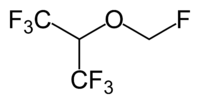- Compound A
-
Strukturformel 
Allgemeines Freiname Sevofluran Andere Namen - Ultan
- 1,1,1,3,3,3-Hexafluor-2-(fluormethoxy)propan
Summenformel C4H3OF7 CAS-Nummer 28523-86-6 ATC-Code N01AB08
DrugBank APRD00219 Arzneistoffangaben Wirkstoffklasse Fertigpräparate Sevorane®
Verschreibungspflichtig: ja Eigenschaften Molare Masse 200,1 g·mol−1 [1] Dichte 1,52 g·cm−3 [2]
Schmelzpunkt < 25°C
Siedepunkt 58,5 °C [1]
Dampfdruck 202,7 mbar (20 °C) [1]
Löslichkeit sehr gut wasserlöslich
Sicherheitshinweise Gefahrstoffkennzeichnung
unbekanntR- und S-Sätze R: ? S: ? Bitte beachten Sie die eingeschränkte Gültigkeit der Gefahrstoffkennzeichnung bei Arzneimitteln Soweit möglich und gebräuchlich, werden SI-Einheiten verwendet. Wenn nicht anders vermerkt, gelten die angegebenen Daten bei Standardbedingungen. Sevofluran ist ein volatiles Anästhetikum aus der Gruppe der Flurane. Es hat eine gute hypnotische, jedoch nur schwach analgetische und muskelrelaxierende Wirkung. Die Verwendung von Sevofluran zur Narkoseführung ist weit verbreitet, vor allem in der Kinderanästhesie.
Inhaltsverzeichnis
Pharmakologie
Der Blut-Gas-Verteilungskoeffizient von Sevofluran ist ca. 0,65, das heißt bei einer Konzentration von 1 Volumenprozent (Vol%) in den Lungenbläschen beträgt die Konzentration im Blut 0,65 Vol%. Die geringe Löslichkeit bewirkt eine schnelle Einschlaf- und Aufwachphase. Die minimale alveoläre Konzentration ist 2 %, Sevofluran ist damit weniger potent als Isofluran. Da Sevofluran nicht schleimhautreizend ist und einen angenehmen „ätherartigen“ Geruch hat, eignet es sich auch für die Narkoseeinleitung. Dies erklärt den häufigen Einsatz in der Kinderanästhesie.[1]
Die Dichte von Sevofluran beträgt als Flüssigkeit 1,52 g/ml [2], der Siedepunkt liegt bei 58,5 °C, der Dampfdruck beträgt bei 20 °C 23,1 kPa.[1]
Die Metabolisierungsrate von Sevofluran liegt zwischen 3 und 5 %. Dabei wird neben Hexafluoroisopropanol anorganisches Fluorid freigesetzt. Weder bei Gesunden noch bei Nierenerkrankten konnte eine Beeinträchtigung der Nierenfunktion (Nephrotoxizität) durch diese Stoffwechselprodukte gezeigt werden.[1] Eine Besonderheit von Sevofluran ist die Reaktion mit dem Atemkalk der halbgeschlossenen Narkosesysteme. Dabei entstehen verschiedene Abbauprodukte (Compound A-E), begünstigend sind dabei ein niedriger Frischgasfluss (Low-Flow-, Minimal-Flow-Narkose), trockener Atemkalk, der Natriumhydroxid oder Bariumhydroxid als Katalysator enthält, sowie hohe Gaskonzentrationen. Compound A wirkt im Tierversuch in hohen Konzentrationen nierenschädigend (nephrotoxisch), was aber bei der klinischen Anwendung beim Menschen keine Rolle spielt. Für Compound B-E konnte bisher keine schädigende Wirkung nachgewiesen werden. Sevofluran ist in Deutschland für Low-Flow- und Minimal-Flow-Narkosen ohne zeitliche Begrenzung zugelassen.[1][3]
Herstellung
Synthesen für Sevofluran sind in der Literatur beschrieben. [4]
Einzelnachweise
- ↑ a b c d e f g Rossaint, Werner, Zwissler (Hrsg.): Die Anästhesiologie. Allgemeine und spezielle Anästhesiologie, Schmerztherapie und Intensivmedizin. S. 297−320. Springer, Berlin; 2. Auflage 2008. ISBN 978-3-540-76301-7
- ↑ a b Sun R, Watcha MF, White PF, Skrivanek GD, Griffin JD, Stool L, Murphy MT: A cost comparison of methohexital and propofol for ambulatory anesthesia. Anesth Analg. 1999 Aug;89(2):311-6. PMID 10439739
- ↑ Förster H, Warnken UH, Asskali F.: [Various reactions of sevoflurane with the individual components of soda lime] Anaesthesist. 1997 Dec;46(12):1071-5. PMID 9451491
- ↑ Axel Kleemann, Jürgen Engel, Bernd Kutscher und Dietmar Reichert: Pharmaceutical Substances, 4. Auflage (2000), 2 Bände erschienen im Thieme-Verlag Stuttgart, ISBN 978-1-58890-031-9; seit 2003 online mit halbjährlichen Ergänzungen und Aktualisierungen.
Literatur
- M. Alef und G. Oechtering: Praxis der Inhalationsanästhesie. Enke-Verlag 2003. ISBN 3-8304-1015-8
Bitte beachte den Hinweis zu Gesundheitsthemen!
Wikimedia Foundation.
